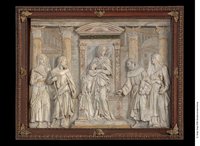Von einer streng symmetrischen Komposition, wie wir sie auf den venezianischen Zierplatten wiederholt finden, ist der linke Pfau teilweise erhalten. Sein linker Fußberührt die geriefelte Wandung eines Gefäßes, über dem sich die Säule eines Springbrunnes erhebt. Das Motiv des Lebensbrunnens ist hier also in der üblichen Weise mit den Pfauen, den Vögeln des Paradieses und des ewigen Lebens, verbunden. Der Pfau hat den Kopf zurückgewendet, sein Gefieder ist in schematischer Weise stilisiert.
Entstehungsort stilistisch: Kleinasien
Historischer Standort: Kirche von Libyssa bei Dil-Eskelessi
en

